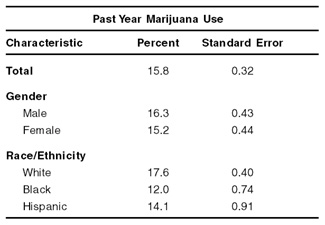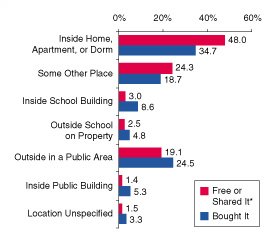
 |
| March 12, 2004 |
|
In Brief |
|
The National Survey on Drug Use and Health (NSDUH), formerly known as the National Household Survey on Drug Abuse (NHSDA), asked respondents to report their use of marijuana during the year prior to the interview. The 2002 survey also asked past year marijuana users to report how they obtained marijuana the last time they used it, from whom they obtained it, and where they were when they obtained it.1,2,3 This report focuses on youths aged 12 to 17, and responses were analyzed by gender and racial/ethnic groups for comparative purposes.4
Table 1. Percentages of Youths Aged 12 to 17 Reporting Past Year Marijuana Use, by Demographic Characteristics: 2002 |
Figure 1. Percentages of Past Year Marijuana Users Aged 12 to 17 Reporting Method of Obtaining Their Most Recently Used Marijuana: 2002 |
 |
 |
Among youths who bought their most recently used marijuana, females (84 percent) were more likely than males (76 percent) to have purchased it from a friend. Males who bought marijuana were more likely than females who bought marijuana to have obtained it from someone they had just met or did not know well (19 vs. 10 percent). There were no gender differences regarding the source of obtaining marijuana among youths who received their most recently used marijuana for free or shared it.
Black youths were less likely than white or Hispanic youths to have obtained marijuana from a friend, regardless of whether they bought it or obtained it for free or shared it. Among youths who bought marijuana, blacks (32 percent) were more likely than whites (15 percent) and Hispanics (10 percent) to have purchased it from someone they had just met or did not know well. Among youths who obtained marijuana for free or shared it, blacks (18 percent) were more likely than whites (9 percent) or Hispanics (7 percent) to have obtained it from a relative or family member.
There were no gender differences regarding where marijuana was purchased among youths who bought it. However, among youths who obtained marijuana for free or shared it, males were less likely than females to have obtained it inside a home, apartment, or dorm (43 vs. 52 percent); and females were less likely than males to have received it in some other place (22 vs. 28 percent).
Among past year marijuana users aged 12 to 17, blacks were more likely than whites to have obtained marijuana outside in a public area and less likely than whites or Hispanics to have received it inside a home, apartment, or dorm, regardless of whether the marijuana was purchased (data not shown).
Almost 14 percent of youths who bought marijuana did so on school property (9 percent inside a school and 5 percent outside on school property). Among youths who bought their most recently used marijuana, white youths (9 percent) were more likely than black youths (4 percent) to have purchased it inside a school building.
Figure 2. Percentages of Past Year Marijuana Users Aged 12 to 17 Reporting Source of Their Most Recently Used Marijuana by Method Obtained: 2002 |
Figure 3. Percentages of Past Year Marijuana Users Aged 12 to 17 Reporting Location of Their Most Recently Used Marijuana, by Method Obtained: 2002 |
 |
 |
*Youths who had not bought or traded for marijuana in the past year and who obtained their most recently used marijuana for free.
| The National Survey on Drug Use and Health (NSDUH) is an annual survey sponsored by the Substance Abuse and Mental Health Services Administration (SAMHSA). Prior to 2002, this survey was called the National Household Survey on Drug Abuse (NHSDA). The 2002 data are based on information obtained from 68,216 persons aged 12 or older, including 23,645 youths aged 12 to 17. The survey collects data by administering questionnaires to a representative sample of the population through face-to-face interviews at their place of residence.
The NSDUH Report is prepared by the Office of Applied Studies (OAS), SAMHSA, and RTI International in Research Triangle Park, North Carolina (RTI International is a trade name of Research Triangle Institute). Information and data for this issue are based on the following publication and statistics: Office of Applied Studies. (2003). Results from the 2002 National Survey on Drug Use and Health: National findings (DHHS Publication No. SMA 03–3836, NHSDA Series H–22). Rockville, MD: Substance Abuse and Mental Health Services Administration. Also available on-line: Because of improvements and modifications to the 2002 NSDUH, 2002 estimates should not be compared with estimates from the 2001 or earlier versions of the survey to examine changes over time. |
| The NSDUH Report (formerly The NHSDA Report) is published periodically by the Office of Applied Studies, Substance Abuse and Mental Health Services Administration (SAMHSA). All material appearing in this report is in the public domain and may be reproduced or copied without permission from SAMHSA. Additional copies of this report or other reports from the Office of Applied Studies are available on-line: http://www.oas.samhsa.gov. Citation of the source is appreciated. |
|
 This page was last updated on May 16, 2008. |